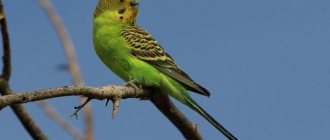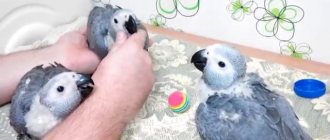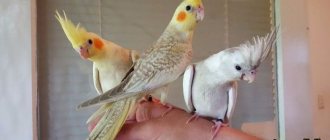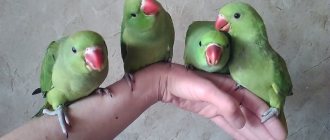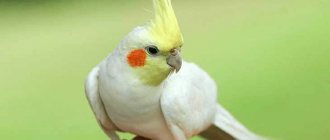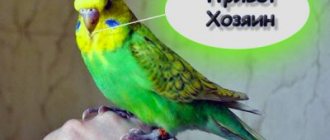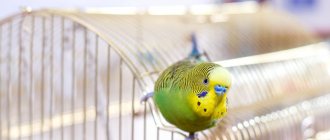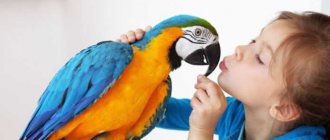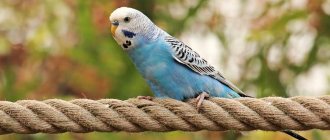Parrots are the only species of birds capable of remembering and reproducing human speech. Thanks to this feature, they are very popular among poultry lovers. But we must remember that their speech skills are not innate, but are acquired in the process of long-term training. In our article we will try to answer the question of how to teach a parrot to speak.
At what age is it better to learn to speak?
When deciding how to teach a budgerigar, cockatiel, gray parrot or other species to speak, you should always remember that young birds are more amenable to speech training. Teaching an adult parrot to speak words may not work. The optimal age for starting training is different for different types of parrots.
Budgerigars can be trained at 30-45 days of age. After 3-4 months of painstaking work, results can be obtained. The ideal age for training a cockatiel is 4-9 months. He learns faster than the wavy ones.
Gray parrots can begin to be trained in the age range of 3 to 9 months. By the way, this is the most capable representative of the entire extended family for learning speech. True, keeping it at home is more difficult than cockatiels or wavy birds.
Budgerigar: can he learn to talk in one day?
The budgerigar is a bird that brings joy with its chirping and playful disposition. You definitely won’t get bored with such a pet! Another advantage of the parrot is its ability to talk. Therefore, owners who have purchased a bird certainly want to teach their pet the wisdom of human speech.
In fact, pushing a parrot to communicate with a person is not so easy. In order for a pet to repeat at least one word, months of training are required. Therefore, do not believe posts on the Internet that promise that the bird will speak in one day or even a week. This is simply impossible.
Photo: pixabay.com: UGC
On average, training a parrot will take about 3 months. The deadline can move in one direction or the other depending on the pet's ability.
Important note: if you want to train a parrot, do not do it immediately after purchasing it. Wait a week or two for your pet to get comfortable and get used to you. First, gain the bird’s trust, and only then stimulate him to new knowledge.
What types of parrots learn faster?
The fastest-learning varieties of parrots include:
- Amazon. Experts believe that these birds learn spoken language faster than all other large representatives of the family. They are able to remember and reproduce 50-60 words.
- Budgerigars are the fastest learning small species. Vocabulary is often limited to 10-20 words, pronunciation is unclear.
- Corella. Talking cockatiels are very popular among bird lovers. On average, their vocabulary reaches several dozen words.
- Macaw. The vocabulary is very low - up to 20 words. But scientists have found that macaws are the smartest of the parrots. They are able to connect words and events, build an associative chain of thinking.
- Cockatoo. Speech training of representatives of this genus leads to the fact that birds begin to pronounce words well and legibly. Their vocabulary can include up to several dozen words.
- Jaco. If a bird lover wants to get a 100% talking parrot, then this is the choice for him. These birds are distinguished by the most developed speech abilities of all members of the family. They can remember and reproduce over 100 words and speak in phrases. The intellectual level of the Gray Gray is very high and corresponds to the level of a five-year-old child.
When will he speak?
How long does it take to train a bird? Much here depends, of course, on her individual abilities - some birds have an excellent gift for imitation. A “gifted” parrot can begin to try to pronounce individual sounds of human speech already in the first day. But clear pronunciation of syllables, words, and even more so phrases require a lot of practice. Parrots master the first word on average in a week to a month.
Remember that learned words must be repeated so that the parrot does not forget them
They remember memorized words for a long time, although without practice, clarity of pronunciation may be lost over time, syllables may become confused (for example, a bird can put two words into one, or even replace parts of words with chirps).
So getting your bird to talk is quite possible, and not even too difficult. In addition to the usual “Goshi or Kesha” and “hello-bye,” come up with a few funny phrases that you will teach your parrot. For example, the famous cartoon “Tahiti, Tahiti! They feed us well here too.” Then an uninterrupted source of positivity will appear in your home. And no matter how successful the day was, you can be sure that when you come home, you will certainly smile.
Who is more capable - males or females?
Many years of practical experiments and observations show that males learn to speak faster than females and have a larger vocabulary. This is due to the fact that their vocal cords are much more developed. In the wild, boys have to sing quite often, including during mating games. So, if a person wants to buy a parrot that will speak well, he should focus on the gender of the bird he is purchasing.
But speech training of females is not at all a hopeless task. Despite the fact that girls study longer and have a smaller vocabulary, they pronounce words much more clearly. So you don’t have to think long about whether it is possible to teach a female budgerigar to speak. We need to start the process.
Does a parrot's gender affect its ability to speak?
According to most bird trainers, it is believed that it is much easier to teach a boy the ability to pronounce words than a girl. This fact is confirmed by examples of a record vocabulary possessed by males. So the most sociable is the budgerigar Puck, who knew 1770 words. However, this does not mean that girls cannot “speak” at all. The exception is the female Australian parrot. To teach your budgie boy to talk, there are a few important things you should know.
The key to fast and high-quality training
When solving the question of how to teach a parrot to talk in practice, you must adhere to some rules, otherwise the result of the process will be negative.
Regular classes
To teach your pet to speak, you need to work with it systematically. Lessons should take place every day and take approximately 15-25 minutes. Once a week you can conduct a kind of control session lasting 35-45 minutes.
Insulation
Experts recommend isolating a parrot whose owner wants to teach him to speak. Neighbors in the cage make it difficult to concentrate and distract the bird’s attention during lessons. Some experts recommend removing unnecessary toys and accessories from the cage.
Nothing should distract the pet's attention from activities, otherwise achieving the goal is not guaranteed.
No stress
The atmosphere during classes should be calm and friendly. The bird should not be afraid of anything, otherwise a good result may not be expected. Therefore, you can only train parrots that have already adapted to their living conditions.
It is worth mentioning separately:
- Inadmissibility of punishment. Their use will have the completely opposite effect.
- The need to conduct a lesson only in a good mood. Birds feel the emotions of their owners. A person’s manifestation of irritability will not go unnoticed. Psychological contact with a feathered pupil can be hopelessly damaged.
Motivation
Motivation is extremely important in the learning process. You can achieve a positive attitude in your parrot and a desire to learn new words by giving him a treat every time after successfully completing a task.
Patience
Patience and work will grind everything down, says a Russian folk proverb. This fully applies to the training of parrots. The person handling the bird should not try to force things too much. He should not abandon the process after the pet’s first failures. All difficulties will be overcome after persistent and systematic work.
Characteristics of the bird
Necklace parrots have beautiful light green plumage and a distinctive dark necklace-like stripe around the neck. This species characteristic is inherent only in males; females do not have it. Their plumage is paler than that of the opposite sex. The feathers on the bird's head are blue, and the edging around the eyes is orange.
Currently, the genus of ringed parrots includes 12 species. All of them can have a variety of colors: gray, pink, white, but the ring around the neck is their common distinguishing feature.
How to teach a parrot to pronounce sounds clearly
When training a budgerigar, you may encounter the fact that the bird speaks unclearly. The same problem exists in other species. There are two reasons for its occurrence:
- The teacher himself has unclear pronunciation. In this case, he needs to think about how to adjust his diction.
- Lack of speech practice in birds. In this situation, you need to think about how best to organize activities with your pet.
Patience and hard work by the trainer with the pet and on himself will definitely lead to a positive result.
Interesting Facts
At the beginning of the article it was said that birds can even carry on conversations, but we embellished the reality a little - in fact, parrots reproduce, imitate your speech or some sounds, so in order for your Keshka to learn to say words on the spot and thereby entertain you and your guests will have to work a little extra. In fact, there is nothing difficult about this, you just need to do a little training.
Photo from the site www.popugai2.ru
For example, you want your friend to greet you from work with the word “hello,” so when you open the apartment door, say “hello” very clearly, loudly and clearly, every time, and after that give your baby a treat. After several lessons, the bird will remember that the treat is associated with the word hello and your return home.
Errors in learning
- Unsystematic activities. Irregular lessons do not bring the desired result, but lead to disappointment. The bird simply does not remember the material taught to it. Speech abilities simply do not develop with such an organization of classes.
- Conducting a lesson in a bad mood. This leads to psychological breakdowns in the teacher, which leads to stress for the parrot and loss of contact with him. And without contact with the student, no educational process is possible. It will simply turn into torment for both the teacher and the student.
- Use of punishments. The bird simply does not understand their meaning and they are interpreted as hostile actions. The result is rejection from the person. The planned result is unlikely to be fully achieved.
Let's automate the process?
Some resourceful bird owners try using a tape recorder for training. It seems so convenient - I wrote down a phrase once and played it for at least half an hour, at least half a day. And you don’t need to waste your own time and nerves on monotonous “droning.” Mind your own business, and the parrot sits and learns... Simple and brilliant? Not really.
Firstly, a parrot, even having memorized phrases behind a tape-recorder voice, may refuse to talk “in public.” To avoid having to listen to bird speech exclusively from behind the doors, at least stay in the room during the audio lesson.
A parrot perceives a tape recording worse than live human speech.
Secondly, the scarecrow will perceive a tape recording that plays for a long time simply as background noise, and training will not take place.
Thirdly, if you want your parrot to say a word or phrase in response to some external action (say, say “hello” when you enter the room, “handsome” when he sees himself in the mirror), the tape recorder will not do anything will help. Let us remind you once again that the bird does not understand the meaning of words. It can produce the “necessary” combinations of sounds only at the level of a reflex to a certain situation, and only you can form such a reflex. For example, every time you show your parrot a mirror, repeat “handsome”, and he will associate this word with your action.
If you still want to use tape recordings, do it not at the very beginning of training, but when the bird begins to pronounce at least one word.

